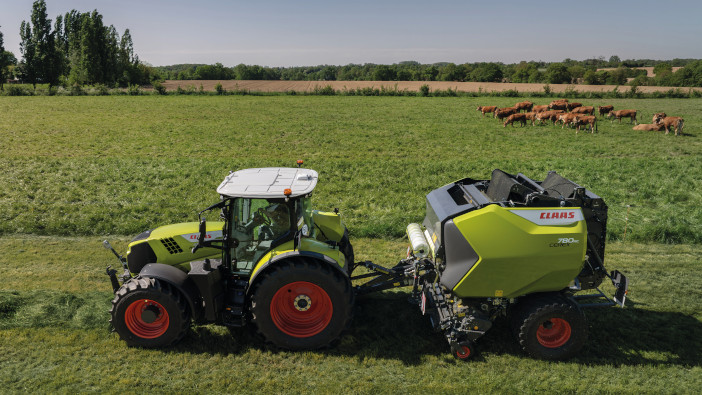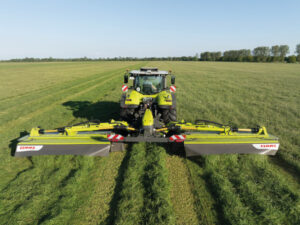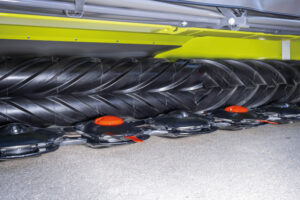As part of its Agritechnica launch schedule, Claas has announced a series of new models and updates across its grassland portfolio and handling range
Headlining the changes to the grassland range was the company’s new Cerex 700 RC variable chamber baler, designed to add higher-capacity, higher-density units above the existing Variant 500. According to the company, it can produce up to 60 high-density bales an hour, driven through a 1,000rpm PTO drive and using the five-row Multiflow pick-up and spiral feed rotor.
After the 2.1m pick-up – brought across from the Rollant 630 RC Uniwrap – crop is transferred to the chamber with the Roto Cut feed rotor, equipped with 8mm double tines, arranged in a spiral pattern. These push the crop through the optional knife bank, which has a bank of 25 knives (activated as 0/12/13/25) for a theoretical chop length of 44mm. In thicker crops, the Pro cutting frame can open to 30mm while retaining cutting quality, and lowered hydraulically through the Isobus screen if a blockage does occur.
It’s fitted with a brand-new chamber, which has two endless heavy-duty belts with continuous cleaning throughout. The hydraulic system has also been revamped, with a new clamping arm cylinder, which Claas says helps the machine to achieve bale densities of over 135kg/cu m. As the belts completely encompass the bale, it also says that crumbling losses are kept to a minimum.
On the 760 model, bale diameters can be varied between 0.9m and 1.6m, increasing to 0.9m to 1.83m on the 780. Both machines come with Isobus functionality, with the ability to adjust the pressure from the cabin. According to Claas, the separate hydraulic system enables this pressure and bale density to remain consistent, even at high forward speeds, and both balers are also offered as standard with soft core function for hay and silage.
When the net is applied, a hydraulically driven brake has been integrated, which is said to provide optimum net tension and save up to 15% in material. The tying system uses a duckbill to insert the net quickly, enabling time to be saved when changing rolls.
The full driveline has been re-engineered with robust, low-wear components, reinforced load points and high-performance bearings. It’s designed to handle up to 216hp, transferred through the PTO and split from the main gearbox. The left side drives the bale chamber, while the right runs the cutting rotor via a duplex chain.
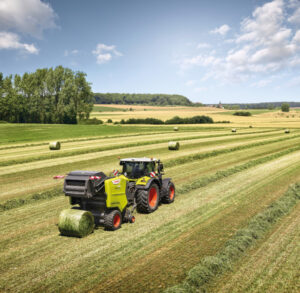 Rollant and Variant updates
Rollant and Variant updates
As well as the introduction of the Cerex, Claas announced a non-wrapping variant of the Rollant 630 RC, replacing the existing 540, 455 and 454 machines. Like the Cerex and the wrapper model, it uses the Multiflow 2.1m pick-up and the Roto Cut system. A choice of a 17-blade cutting rotor or a knife bank are available, with groups of 17/0, 17/9/8/0 or 25/13/12/0 activated electro-hydraulically.
The cleaning system from the Cerex has been integrated, as has the Pro cutting frame with the ability to open and allow thicker crops through. Other improvements include a larger chain lubrication tank and central lubrication system, and the areas of greatest stress have been adapted from the Quadrant large square balers.
A 16-roller chamber is fitted, with the Maximum Pressure System II (MPS II), which provides additional pressure with a swivelling three-roller segment and dual spring set-up at the rear. During formation, this protrudes into the chamber and is subsequently pushed back into its resting position by the bale as the diameter increases.
The Multiflow pickup has also been integrated across the Variant variable chamber balers, bringing them in line with the new Cerex range. Like the rest of the Claas balers, there have also been updates to the digital management systems, with all models connected to the Claas connect system.
Disco mowers
Starting at the top of the mower range, Claas has uprated its Disco 1100 C and RC Business machines, offering working widths from 9.6m to 10.7m. The telescopic arms that enable the width adjustment have been reinforced and fitted with spring-loaded sliding elements to maintain a constant pressure.
Each arm can be adjusted independently of the other or synchronised to maintain the correct overlap. As standard, both the RC and C machines come with Active Float hydropneumatics ground pressure control, while the optional slope control allows the machine to automatically adjust ground pressure and overlap with the front mower depending on the side slope.
A new headstock has been fitted, with a swivel to enable easier access when coupling or uncoupling machine. Elsewhere, the two models retain the proven Max Cut mower bar, with lifetime lubrication and a wavy profile that pulls grass between the intermeshing blades for a clean cut.
Operators have the choice of a polyurethane roller conditioner, with double-drive to minimise the risk of blockages, or a tine conditioner with spirally arranged steel Y-tines. With the Business specification, the mowers also benefit from load-sensing and Isobus control for semi-automated operation.
The Disco Contour offset mounted mowers have also been renewed, offering 12 models with working widths ranging from 2.6m up to 4.2m. These also benefit from the Max Cut bed, as well as Active Float suspension as standard.
The latest generation is also offered with a counterweight to even the load across the tractor’s rear axle. According to the company, this will improve performance on slopes and allow headland turns to be made at a faster speed. Depending on the working width of the mower unit, the weight can be adjusted as it is made up of individual weight blocks.
Vector folding has been integrated, allowing the mower to fold 120deg over the centre of gravity for safe road transport. With the largest 4400 Contour machine, this enables a +7m working width in the field when combined with the Disco 3200 F Profil or Move machines, while retaining a transport height of below 4m.
Roller or tine conditioners are available, and all models come with infinitely adjustable swathing plates as standard. Models equipped with the roller conditioner can also be optioned with telescopic swath plates for narrow swaths in certain crops.
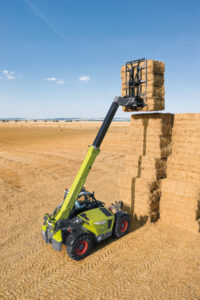 8m Scorpion fills out the range
8m Scorpion fills out the range
Rounding out the first batch of Agritechnica announcements, Claas has continued its collaboration with Liebherr with the new Scorpion 848 telehandler model.
Powered by a Deutz four-cylinder engine which puts out 156hp, the new model can lift a maximum of 4.8t, with a lifting height of 8m. The Dynamic Power system automatically adjusts the engine speed proportionally with the position of the loader joystick, meaning that the operator always has the desired power for the task at hand.
When the telescopic arm is lowered without a load on the front, the engine speed automatically reduces.
Power is put to the ground through the stepless Varipower Plus hydrostatic transmission, with a 45deg pivot angle at the hydrostat and a second variable displacement motor with a 32deg pivot. According to the company, this provides up to 103kN thrust and up to 20t towing capacity.
The articulation point of the boom is mounted low into the chassis for improved stability, with long overlaps across each telescoping section for greater rigidity. Claas has also integrated its Smart Loading features into the machine, offering automatic bucket return, bucket shake and automatic retraction of the telescope during lowering.
The load-sensing hydraulic system is rated at 187 litres/min, with a 270bar working pressure.
It brings the company’s Scorpion range up to nine models, offering capacities from 3,000kg up to 6,000kg and maximum lifting heights between 6.23m and 9.75m. These are developed and manufactured in the Liebherr plant in Telfs, Austria.


